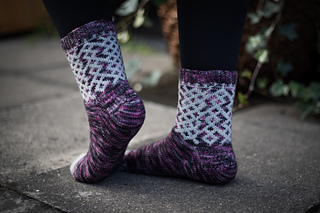patterns >  Skeindeer Knits
Skeindeer Knits
> Probably Cursed Socks








Probably Cursed Socks
Probably cursed because the design process of these socks took more years than I can remember for absolutely no reason what so ever. They’re a fun varied knit, starting with toe shaping, a bit of colourwork, a mindless section of stockinette, heel shaping, a colourwork leg, and finishing with a short ribbed cuff.
To better fit in shoes, the stockinette foot has smaller circumference than the colourwork leg, so that the socks fit firmly around your feet.
I hope you will enjoy this pattern, and if you need any help, please do not hesitate to contact me in my Ravelry group ‘Skeindeer Knits’. It’s the best place for swift support.
Yarn
Stranded Dyeworks BFL Nylon Fingering (80% Bluefaced Leicester wool, 20% Nylon, 366 / 400 yds, 100g).
Main colour: 100-130 m / 110-145 yds.
Contrast colour: 225-255 m/ 245-280 yds.
Or any other fingering weight sock-yarn with around 25% nylon and about 180-220 m / 200-240 yds per 50 g, such as Opal 4ly, West Yorkshire Spinners Signature 4ply or Regia 4ply, with around 25% nylon and about 200 m / 219 per 50 g.
Needles
Gauge-size needles to work short circumference in the round.
The sample was made using 2.5 mm (US 1 1/2) for stockinette stitch and 2.75 mm (US 2) for stranded colourwork.
Gauge
(36, 34, 32) sts x 46 rnds = 10 cm / 4” in stockinette (stranded colourwork).
Sizes
(1, 2, 3), achieved by gauge.
The sample is size 2, worn with 2.5 cm / 1” negative ease at the widest part of the foot.
Sock foot circumference:
(18, 19, 20) cm / (7, 7.5, 8)”
Sock leg circumference:
(20, 21.25, 22.5) cm / (8, 8.25, 9)”
Leg length:
13 cm / 5”
Notions
1 stitch marker
Construction
The socks are worked toe-up in the round, starting with increasing from the tip of the toe, working the length of the foot, and then increasing for the heel gusset. Finally, finish with the colourwork leg and the ribbed cuff.
Somewhat unique to this pattern is how the leg is about 2-2.5 cm / 1” larger in circumference than the foot, for better fit and use with shoes. To achieve this, the pattern tells you to decrease less at the heel flap than you increased for the gusset.
Gauge grading
Gauge grading is an old Norwegian method of achieving multiple sizes in a fixed colourwork pattern. This is done by using bigger needles for bigger sizes and smaller needles for smaller sizes. Use the needle size that gives you the gauge listed for your size.
21723 projects
stashed
12642 times
29303 projects
stashed
12133 times
30547 projects
stashed
18464 times
916 projects
stashed
1185 times
- First published: October 2021
- Page created: October 31, 2021
- Last updated: March 22, 2023 …
- visits in the last 24 hours
- visitors right now





